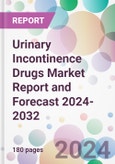Urinary Incontinence Drugs Market Outlook
The urinary incontinence drugs market size is anticipated to grow at a CAGR of 2.98% during the forecast period of 2024-2032, driven by the rising incidence of geriatric population along with technical advancements to treat improved improvement to patients across the globe.Urinary Incontinence: Introduction
Urinary incontinence is the involuntary loss of bladder control, leading to accidental urine leakage. It can range from occasional minor leaks, often triggered by actions like coughing or exercising, to more severe and frequent uncontrollable urination. Causes vary, including weakened pelvic muscles, nerve damage, urinary tract infections, or prostate issues in men. While it affects both genders, it's more common in women, especially post-childbirth or during menopause. Treatment options include pelvic floor exercises, medications, and surgery.Key Trends in the Urinary Incontinence Drugs Market
Pharmaceutical companies are investing in the development of new drugs with fewer side effects and longer-lasting effects. The focus is on creating medications that not only manage symptoms effectively but also improve the quality of life for patients.There's a growing trend towards personalized medicine in treating urinary incontinence. Healthcare providers are increasingly considering individual patient profiles, including genetic factors, to tailor treatments more effectively, enhancing drug efficacy and minimizing side effects.
With rising awareness about urinary incontinence and its impact on quality of life, more individuals are seeking medical advice and treatment. This trend is leading to an increase in the diagnosis and treatment of the condition, subsequently driving the demand for therapeutic drugs.
The aging global population is a significant driver for the urinary incontinence drugs market. Older adults are more susceptible to urinary incontinence due to age-related weakening of bladder muscles and issues like prostate enlargement in men, driving the demand for effective treatment solutions.
Regulatory bodies are providing support in the form of fast-track approvals for urinary incontinence drugs, especially those that demonstrate significant improvements over existing treatments or cater to previously unmet medical needs.
There is an increasing interest in combination therapies, where drugs are used in conjunction with non-pharmacological treatments such as bladder training, pelvic floor muscle exercises, or electrical stimulation to enhance treatment outcomes.
Emerging economies are witnessing market growth due to improving healthcare infrastructure, rising healthcare expenditure, and growing awareness about urinary incontinence and its treatments. Companies are tapping into these new markets to expand their global footprint.
Urinary Incontinence Drugs Market Segmentation
Market Breakup by Incontinence Type
- Urge Incontinence
- Overflow Incontinence
- Stress Incontinence
- Mixed Incontinence
- Other Type
Market Breakup by Drug Type
- Anticholinergic
- Skeletal Muscle Relaxants
- Antidepressants
- Alpha Blockers
- Topical Estrogens
- Others
Market Breakup by Distribution Channel
- Hospital Pharmacies
- Retail Pharmacies
- Online pharmacies
Market Breakup by Region
- United States
- EU-4 and the United Kingdom
- Germany
- France
- Italy
- Spain
- United Kingdom
- Japan
Urinary Incontinence Drugs Market Overview
Urinary incontinence drugs market in North America is highly developed, with the United States leading in both research and pharmaceutical innovation. The region's market is driven by a growing awareness of urinary incontinence issues, high healthcare expenditure, and a well-established healthcare infrastructure. The presence of key pharmaceutical companies, along with a focus on new drug development and a high adoption rate of advanced treatments, supports the market's growth.Europe's market for urinary incontinence drugs is robust, supported by strong healthcare systems and significant investments in healthcare research. Countries like Germany, the UK, and France are key contributors, with an emphasis on improving the quality of life for the aging population, which is prone to urinary incontinence. The region benefits from stringent regulatory guidelines ensuring high-quality healthcare services and products, along with a focus on innovative treatment options and therapies.
The Asia-Pacific region is experiencing rapid growth in the urinary incontinence drugs market. Factors contributing to this growth include an increasing elderly population, rising healthcare awareness, and improvements in healthcare infrastructure. Countries like China, Japan, and India are seeing a surge in demand for urinary incontinence treatments, driven by changing lifestyles, increased healthcare spending, and government initiatives to modernize healthcare facilities.
Urinary Incontinence Drugs Market: Competitor Landscape
The key features of the market report include patent analysis, grants analysis, clinical trials analysis, funding and investment analysis, partnerships, and collaborations analysis by the leading key players.- Johnson & Johnson
- Pfizer
- Astellas Pharma
- Allergan
- Takeda Pharmaceuticals Company
- Merck KGaA.
- Sanofi S.A.
- Kissei Pharmaceutical
- Kyorin Holding
- Urovant Sciences
- Cook MyoSite
- elicept Therapeutics
- Astellas Pharma
This product will be delivered within 5-7 business days.
Table of Contents
1 Preface
3 Urinary Incontinence Overview
4 Patient Profile
5 Urinary Incontinence Drugs Overview
6 Patient Profile
7 Urinary Incontinence Drugs Epidemiology Analysis - 7MM
8 Urinary Incontinence Drugs Market Overview - 7MM
9 Urinary Incontinence Drugs Market Landscape - 7MM
10 Urinary Incontinence Drugs Challenges and Unmet Needs
12 Urinary Incontinence Drugs Market Dynamics
13 Urinary Incontinence Drugs Market Segmentation - 7MM
14 United States Urinary Incontinence Drugs Market
15 EU-4 and United Kingdom Urinary Incontinence Drugs Market
16 Japan Urinary Incontinence Drugs Market
17 Patent Analysis
18 Grants Analysis
19 Clinical Trials Analysis
20 Funding Analysis
21 Partnership and Collaborations Analysis
22 Supplier Landscape
23 Urinary Incontinence Drugs Market - Distribution Model (Additional Insight)
25 Company Competitiveness Analysis (Additional Insight)
26 Payment Methods (Additional Insight)
Companies Mentioned
- Johnson & Johnson
- Pfizer Inc
- Astellas Pharma
- Allergan
- Takeda Pharmaceuticals Company
- Merck KGaA.
- Sanofi S.A.
- Kissei Pharmaceutical
- Kyorin holding
- Urovant Sciences
- Cook MyoSite
- elicept Therapeutics
- Astellas Pharma
Methodology

LOADING...








